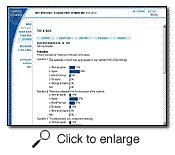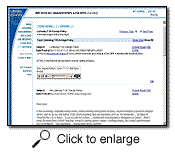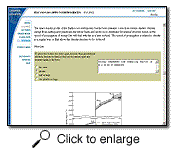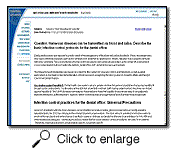|
 Guest lecturers provide a lot of the in-class
material in this intensive, year-long course. To evaluate each lecture's
effectiveness, professor Dickstein needs a way to quickly and easily
gather his students' impressions. His solution has been to use the
Test & Quiz section of CourseWorks to prepare and disseminate weekly
on-line lecture evaluations to his students.
Guest lecturers provide a lot of the in-class
material in this intensive, year-long course. To evaluate each lecture's
effectiveness, professor Dickstein needs a way to quickly and easily
gather his students' impressions. His solution has been to use the
Test & Quiz section of CourseWorks to prepare and disseminate weekly
on-line lecture evaluations to his students.
Using the Test & Quiz feature in this way, professor
Dickstein is now able to poll his students with multiple choice
and short answer questions that assess the lectures’ relevance,
the quality of the presentations, and how well the students understand
the topics. Additionally, by asking his students to list the three
main points of each lecture and make any additional comments, professor
Dickstein is able to gather any additional feedback that his students
wish to share.
When the students have completed the survey,
CourseWorks automatically generates a series of graphs of the poll
results. Through these visuals professor Dickstein can quickly determine
the value of a given lecture based on his students’ feedback.
The automation of this data collection and visualization frees professor
Dickstein from the normally laborious task of administering, collecting,
and tabulating student polls. Instead, he can focus on more meaningful
tasks related to teaching his students.

 In
this School for International and Public Affairs course, international
graduate students focus on English language communication skills.
Specifically, students focus on improving their speaking skills
by delivering weekly in-class oral presentations. In
this School for International and Public Affairs course, international
graduate students focus on English language communication skills.
Specifically, students focus on improving their speaking skills
by delivering weekly in-class oral presentations.
As a means of extending her students’ ability
to evaluate their own performances, Leila May-Landy uses the Discussion
section of CourseWorks in conjunction with ThirdSpace (a discussion
board-based tool that can excerpt segments of video and/or audio
directly into postings) to create on-line "portfolios" in which
she and her students can present and analyze samples of oral presentations.
Using CourseWorks and ThirdSpace in this manner provides Leila May-Landy
and her students with a flexible workspace in which to communicate
and extend many of their other in-class activities. For students
and teacher alike, some of the most notable benefits of this solution
are:
- The instructor can create and distribute feedback in both written
and oral form so that students can not only read about their mistakes
but also hear corrections.
- Students have the ability to watch their own and their peers’
oral presentations as often as they like so they can discover
speaking mistakes that they might otherwise miss.
- ThirdSpace, unlike a traditional VCR setup, allows students,
as well as Leila May-Landy to 'index' important sections of a
video of an oral presentation so that the relevant sections can
be easily accessed when the presentation is being analyzed or
critiqued.
As a result, Leila May-Landy’s use
of CourseWorks extends and enhances many common ESL instructional
methods in ways that could not otherwise be accomplished in a traditional
classroom-based learning environment. Course evaluations show that
using CourseWorks in this manner contributes to students’ increased
ability and confidence to speak English correctly.

 This
course challenges non-science majors to learn the science skills
necessary to undertake a polar expedition, to read and discuss the
accounts of past polar explorers, and to produce personal journals
based on their own simulated polar expedition. The main obstacles
students face in completing these requirements are their lack of
background knowledge and terminology for thinking, arguing, and
writing meaningfully in a scientific context. Stephanie Pfirman
and Robin Bell’s solution is to use the Discussion section
to create space in which students write their personal journals
and in which the instructors can provide quick, formative, and confidential
feedback on each student’s weekly writings. This
course challenges non-science majors to learn the science skills
necessary to undertake a polar expedition, to read and discuss the
accounts of past polar explorers, and to produce personal journals
based on their own simulated polar expedition. The main obstacles
students face in completing these requirements are their lack of
background knowledge and terminology for thinking, arguing, and
writing meaningfully in a scientific context. Stephanie Pfirman
and Robin Bell’s solution is to use the Discussion section
to create space in which students write their personal journals
and in which the instructors can provide quick, formative, and confidential
feedback on each student’s weekly writings.
By providing feedback in this manner, Stephanie
Pfirman and Robin Bell are better able to quickly catch and correct
students’ mistakes relating to scientific writing with the
goal of improving future journal entries. Additionally, by using
CourseWorks, they construct a comprehensive learning environment
where students can access the course's specially designed simulated
polar expedition site, engage in on-line collaborative writing,
view the course syllabus, access various class notes, and receive
assignments. Pfirman and Bell have constructed an extension to their
class that helps students to engage in aspects of scientific thinking,
writing, and hypothesis formulation, which might otherwise be a
difficult task in a classroom-only setting.

 In
this fast-changing field of study, one where new theories and information
appear on a weekly basis, agile access to the most recent information
is crucial. Since Professor Pollack wants his students to learn
using the most up-to-date material possible, it is important to
him to have an effective method for collecting and disseminating
the latest materials to his students. Given that most of the materials
that Professor Pollack uses in his class incorporate diagrams and
illustrations that need to be represented clearly and accurately,
he also needed a solution that enabled him to manage high-quality,
color graphics. The use of the Files section of CourseWorks as of
means of archiving and disseminating digital PDF (Adobe Portable
Document Format) materials created from on-line journals was a simple
solution to professor Pollack's challenge. In
this fast-changing field of study, one where new theories and information
appear on a weekly basis, agile access to the most recent information
is crucial. Since Professor Pollack wants his students to learn
using the most up-to-date material possible, it is important to
him to have an effective method for collecting and disseminating
the latest materials to his students. Given that most of the materials
that Professor Pollack uses in his class incorporate diagrams and
illustrations that need to be represented clearly and accurately,
he also needed a solution that enabled him to manage high-quality,
color graphics. The use of the Files section of CourseWorks as of
means of archiving and disseminating digital PDF (Adobe Portable
Document Format) materials created from on-line journals was a simple
solution to professor Pollack's challenge.
"Digital" PDF documents (e.g. PDF files
created directly from the Web or a word processor using Adobe's
Acrobat Distiller) offer several advantages over scanned PDF documents:
- digital PDFs offer a much smaller file size so students can
easily download them
- digital PDF's images and text are presented crisply and in
full-color, whereas scanned PDF documents often have fuzzy low-resolution
text and graphics that print poorly.
- digital PDF documents store textual information in a substrate
so they can be easily searched and indexed.
After consulting with the Columbia Center for
New Media Teaching & Learning (CCNMTL) and Columbia University Libraries,
Professor Pollack has been able to quickly and easily create and
distribute high-quality materials to his students through his CourseWorks
site.

 In
this introductory Earth sciences course, Professor John Mutter and
his co-teacher, Roger Anderson, want their students to learn not
only facts about the Earth, but to explore our ability to predict
its behavior as well. In
this introductory Earth sciences course, Professor John Mutter and
his co-teacher, Roger Anderson, want their students to learn not
only facts about the Earth, but to explore our ability to predict
its behavior as well.
This teaching method is something of a departure
from the standard curriculum, so Professor Mutter created an online
multimedia textbook several years ago, which has recently been updated
and incorporated into CourseWorks.
In the syllabus section, the instructors present
their alternating "textbook" chapters, which embed multimedia
elements where they are most effective. Students have an opportunity
to learn at their own pace and evaluate their understanding from
time to time with mini-quizzes and other exercises that Professor
Mutter embeds within the textbook.
This course is available to
the public

 In
this class, which focuses on small group assignments, students conduct
research on dental techniques in an effort to find authoritative
sources, apply critical thinking, organize information, and work
collaboratively to produce a comprehensive manual for use by the
class. One of Professor Zimmerman’s goals is that each student
truly participate in the group work. To facilitate this, he requires
each student to independently research the case and submit his or
her findings to the group's discussion section. These resources
are used to compose a final lab manual section. In
this class, which focuses on small group assignments, students conduct
research on dental techniques in an effort to find authoritative
sources, apply critical thinking, organize information, and work
collaboratively to produce a comprehensive manual for use by the
class. One of Professor Zimmerman’s goals is that each student
truly participate in the group work. To facilitate this, he requires
each student to independently research the case and submit his or
her findings to the group's discussion section. These resources
are used to compose a final lab manual section.
An advantage that this use of CourseWorks offers,
is that professor Zimmerman can look at the students’ research
and results throughout the process and provide feedback to the individuals
and groups as they arrive at consensus.
Sometimes students neglect an important piece
of research. Therefore, being able to follow the "paper trail"
backwards, Professor Zimmerman can investigate students' rartionale
for leaving out the information. This often lays bare critical thinking
errors from which the entire class can learn.
This course is available to
the public
|